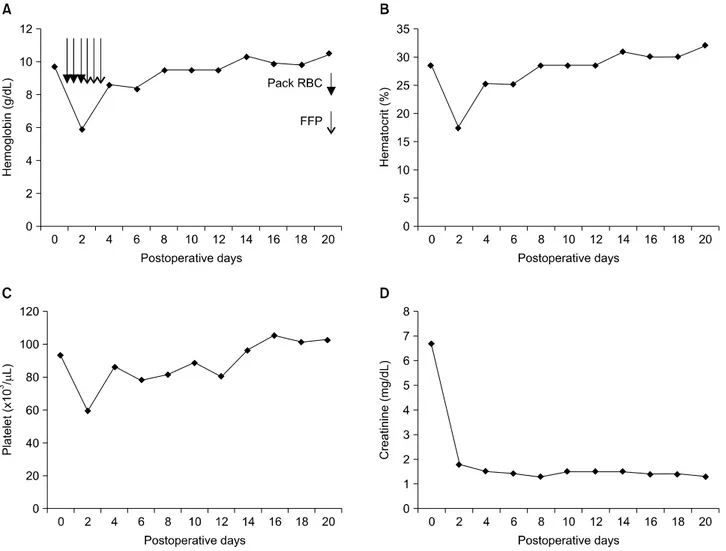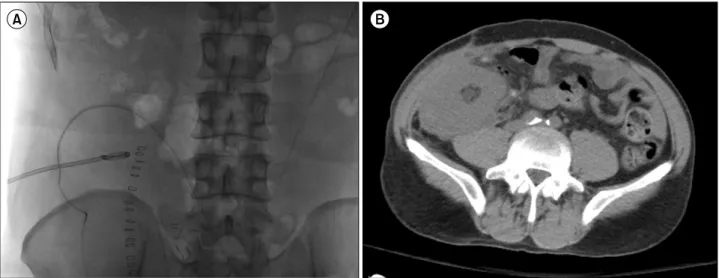Living-donor Sequential ABO-incompatible Kidney Transplantation after Liver Transplantation in a Patient with Alcoholic Liver Cirrhosis
and End-stage Renal Disease
Departments of Surgery
1, Pathology
2, and Anesthesia
3, Gangneung Asan Hospital, University of Ulsan College of Medicine, Gangneung, Department of Surgery
4, Asan Medical Center, University of Ulsan College of Medicine, Seoul, Korea
Jin Ho Kwak, M.D.
1, Hyuk Jai Jang, M.D.
1, Gun Moo Choi, M.D.
1, Chun Soo Park, M.D.
1, Dae Woon Eom, M.D.
2, Seong Su Kim, M.D.
3, Duck Jong Han, M.D.
4and In Koo Kim, M.D.
1A 47-year-old man developed chronic alcoholic liver cirrhosis and end-stage renal disease. He underwent blood-type-compatible liver transplantation with a graft from his daughter. After 8 months, sequential ABO-incompatible (ABOi) kidney transplantation was performed, with his brother as the donor (A to O). The patient had anti-A antibody titers (1:256). We performed pretransplant desensitization, including administration of rituximab, mycophenolate mofetil, tacrolimus, and prednisolone 2 weeks before the scheduled transplantation, and plasmaphresis (PP) and administered an intravenous immunoglobulin injection. The patient un- derwent PP before kidney transplantation until the anti-A antibody titer was <1:8. The patient achieved normal renal function within 4 posttransplantation days. Postoperative bleeding (diffuse hemorrhage) requiring additional blood transfusions and radio- logical intervention (drainage procedure) occurred 9 days after transplantation. The patient was discharged on day 20 of hospitalization. Nine months after the kidney transplantation, the recipient’s and donor’s liver and kidney functions were normal.
ABOi renal transplantation after liver transplantation can be successfully performed in patients with high baseline anti-ABO anti- body titers after preconditioning with rituximab and PP, and quadruple immunosuppressive therapy. However, caution is required regarding an increased risk of bleeding complications.
Key Words: Sequential ABO-incompatible kidney transplantation, Liver transplantation, Bleeding complication
중심 단어: ABO 부적합 신장이식, 간이식, 수술 후 출혈Received March 9, 2015 Revised March 12, 2015 Accepted March 12, 2015
Corresponding author: Hyuk Jai Jang
Department of Surgery, Gangneung Asan Hospital, University of Ulsan College of Medicine, 38 Bangdong-gil, Gangneung 210-711, Korea Tel: 82-33-610-3221, Fax: 82-33-641-8120
E-mail: jhj@gnah.co.kr
INTRODUCTION
Combined liver and kidney transplantation (CLKT) is an effective therapy for end-stage liver disease with chronic renal failure. However, it is a complex surgical procedure and difficult to manage perioperatively. Therefore, we per- formed sequential kidney transplantation (KT; ABO in-
compatible [ABOi]) after liver transplantation. We describe the case of a 47-year-old man who developed chronic alco- holic liver cirrhosis and end-stage renal disease (ESRD). He received a blood-type compatible liver transplant from his daughter. After 8 months, he received a sequential ABOi kidney transplant from his brother (A to O).
In the present case, several clinical obstacles were encoun- tered, such as liver and kidney transplantation (LKT), ABO incompatibility, and bleeding complication after multiple plas- mapheresis (PP). Herein, we discuss these issues in detail.
CASE REPORT
A 47-year-old man had chronic alcoholic liver cirrhosis
Fig. 1. (A) Hemoglobin, (B) hematocrit, (C) platelete, and (D) creatinine levels after kidney transplantation.
and unknown origin ESRD. His blood type was O Rh+. We performed blood type-compatible liver transplantation with a graft from his daughter. His Child-Turcotte-Pugh score was 5, model for end-stage liver disease score was 20, and graft-to-recipient weight ratio was 1.04. He had undergone living donor liver transplantation (LDLT) using by a modi- fied right lobe graft and bile duct anastomosis was made by duct-to-duct. Immunosuppression consisted of pre- dnisolone, tacrolimus, mycophenolate mofetil (500 mg/day).
The target whole-blood trough level of tacrolimus was 8∼
10 ng/mL for the first 4 week and 7∼9 ng/mL thereafter.
The patient had ESRD, and he received hemodialysis 3 times per week via arteriovenous fistula (AVF) of left arm.
He had no complication in hospital days after LDLT, dis- charged on postoperative 24th days. The immunosuppressive therapy remained with prednisolone/taclorimus/mycopheno-
late mofetil. Prednisolone tapered gradually and stopped af- ter 3 months. The function of the transplanted liver was normal.
After 8 months, we also performed sequential ABOi KT, with his brother (A to O) as the donor. The preoperative anti-A antibody titers were 1:256. As pretransplant desensi- tization, we administered rituximab, mycophenolate mofetil (1 g/day), tacrolimus, and prednisolone (10 mg/day) 2 weeks before the scheduled transplantation, performed sev- en PP sessions, and PP was performed every other day and immediately followed by intravenous administration of im- munoglobulin at a dose of 100 mg/kg. In each PP session, one plasma volume was discarded and substituted at 100%
volume with 5% albumin excluding the last session before transplantation; in the last session, we used fresh frozen plasma (FFP). The target whole-blood trough level of tacro-
Fig. 2. Computed tomographic images showing a perinephric hema- toma. An approximately 8×9 cm phlegmonous change with an approximate 5×2 cm fluid collection seen in the right side of the transplanted kidney.
Fig. 3. (A) Plain film showing pigtail drainage in the hematoma location. (B) Computed tomographic image showing the improvement after the drainage procedure: decreased fluid collection around the transplanted kidney in the right iliac fossa.
limus was maintained at 8∼10 ng/mL. We also injected 200 mg of rituximab intravenously 2 weeks before surgery.
After the PP, his laboratory findings were hemoglobin 8.8 g/dl, platelet 88,000/uL, prothrombin time 75% (INR, 1.25), activated partial thromboplastin time (aPTT) 35.4 sec, as- partate transaminase 13 IU/L, alanine transaminase 10 IU/L, total bilirubin 0.3 mg/dL, blood urea nitrogen (BUN) 52.9 mg/dL, and creatinine 7.0 mg/dL, the anti-A antibody titers of the patient were <1:8. Anti-ABO antibody (immuno- globulin G/immunoglobulin M) was checked daily from the
initiation of PP/intravenous immunoglobulin (IVIG) until the 2nd week after transplantation. At first, the target titer at transplantation and during the first 2 weeks after trans- plantation was 1:4. During the surgery, diffuse bloody ooz- ing was observed. At postoperative day 2, the patient needed transfusion of several packed red blood cells and FFP (Fig.
1). There was perinephric hematoma in the radiologic study (Fig. 2). At postoperative day 9, we performed percuta- neous drainage of the perinephric hematoma (Fig. 3). The patient was discharged with good graft function on post- operative day 20. Three year after the procedure, the liver and renal allograft function was normal.
DISCUSSION
Since the first case of simultaneous LKTs by Margreiter in 1983, it has become the only treatment modality for cer- tain patients with irreversible end-stage liver and kidney diseases(1). In our patient who had alcoholic liver cirrhosis and ESRD, living-related sequential liver ABO compatibility and kidney ABO incompatibility transplantations were per- formed with grafts from different donors. In our literature search, we did not find any report of a case similar to the present case.
The superiority between CLKT and sequential liver and kidney transplantation (SeqLKT) is controversial. CLKT and SeqLKT may be considered equal(2). The severity of
surgical stress and the shortage of organs in CLKT make SeqLKT more preferable among surgeons. SeqLKT has the advantage of allowing for a sequential renal transplantation in normal liver function after liver transplantation. There- fore, the coagulation function is normal. In terms of organ shortage, the use of a living-related donor is a good alternative. However, liver and kidney transplant donors are exposed to high risks. In our case, the patient received the liver graft from his daughter and the kidney graft from his brother. More prospective randomized studies are required to compare the operative methods of CLKT and SeqLKT because of the many factors that affect the results, such as original disease and donor characteristics.
With the advancement of immunosuppressive agents and PP, graft survival in ABO-incompatible KT has highly im- proved(3). However, in a previous case of baseline an- ti-ABO antibody titer (>1:256), the patient needed addi- tional sessions of pretransplant PP/IVIG(4). In our case, the preoperative anti-A antibody titer was 1:256. We performed seven PP sessions and administered an IVIG injection (100 mg/kg) until the anti-A antibody titer of the patient was
<1:8. Posttransplant PP is controversial. To deplete the B-cell population in a patient with a high titer, previous re- ports suggested splenectomy or rituximab administration with splenectomy(5). A B-cell-depleting antibody was re- cently discovered that can replace splenectomy in patients with high titers(6). Two weeks before the surgery, we did not perform splenectomy but administered a 200-mg ritux- imab injection intravenously.
Our search of the relevant medical literature yielded 10 reported cases of sequential living donor LKT seven of the 10 patients were infants or small children, two adolescences.
Adult SeqLKT including our experience reported only two cases. SeqLKTs were performed with a mean interval of 3.6 months (22 days∼8 months) between the two procedures in infants and children(7). Adult SeqLKT including our ex- perience were performed with an interval of 8, 10 months between the procedures. More studies are required to com- pare the two procedures interval of SeqLKT because of the many factors that affect the results, such as original disease and donor characteristics.
Recent study reported that pre-emptive transplantation, a high pretransplant BUN level, A high anti-ABO antibody
titer after PP, a low platelet count of ≤100,000/mm3 after PP, and a prolonged aPTT were associated with an increased risk of bleeding after ABOi KT, and the type of substitution fluid used during PP did not result in statistically significant differences between PP and PP using high portion of FFP group(8).
The risk of hemorrhage after PP is increased. After PP, postoperative bleeding is not uncommon. Plasma exchange itself produces a decrease in clotting factors. However, an increase in these factors is noted in a few hours. When mul- tiple PP sessions are performed in a short period, coagulop- athy is prolonged(9). ABOi KT usually needs several PP sessions, as in our case.
In conclusion, CLKT is an effective therapy for end-stage liver disease with chronic renal failure. However, it is a complex surgical procedure and perioperative management is difficult. Therefore, we performed SeqLKT. ABO-in- compatible renal transplantation after liver transplantation can be performed successfully in patient after precondition- ing with rituximab and PP, and quadruple immuno- suppressive therapy. However, the intensified desensitization in patients might be associated with an increased risk of bleeding complications.

